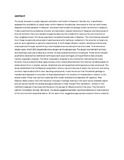| dc.contributor.author | Nyiva, Mutui F | |
| dc.date.accessioned | 2013-05-06T11:39:47Z | |
| dc.date.available | 2013-05-06T11:39:47Z | |
| dc.date.issued | 2007 | |
| dc.identifier.uri | http://erepository.uonbi.ac.ke:8080/xmlui/handle/123456789/19357 | |
| dc.description.abstract | The study focused on waste disposal, sanitation and health in Kasarani, Nairobi city. It
specifically assessed the availability of piped water within Kasarani households. attempted to
find out solid waste disposal methods adopted in Kasarani, and examined household sewage
(toilet) conditions in Kasarani. It also examined the prevalence of water and sanitation related
infections in Kasarani and attempted to find out whether there are suitable measures taken by
the residents to improve the environment of their neighbourhood.
The study population consisted households in Kasarani. The interviewees selected from these
households comprised of adult persons who had been residents in the area Cor at least one
year so as to capitalise on genuine experiences.
A multi-stage (Cluster) random sampling method was employed and through a preliminary
reconnaissance survey along the service roads. 15 streets were chosen upon which 200
households were chosen as the sample size.
The study involved both primary and secondary sources of data as a number of data analysis
tools were employed. These tools included qualitative (descriptive) statistical techniques
such as percentages, and quantitative data analysis. namely regression analysis. The latter
(regression analysis) is the method for estimating the linear function that provides the best
approximate of the relationship between the interval variables based on observations from a
random sample. Graphical and cartograpbical techrtiques were also employed.The study established that the Kasarani population relics on several sources of water the
common one being out-door taps located within their dwelling compounds. It also found out
that household garbage is handled and disposed ill a number of ways depending on the
location of households in relation to the access roads. Those near service roads had their
waste collected and disposed off regularly. Also Kasarani lacks a sewer and this has led to
increase in sewage flowing in the open as the available septic pits can barely handle the
excess sewage produced in these houses. Poor sanitation , evident in the inefficient disposal
VI
services contributes to the spread of infections within the area. This therefore calls for
immediate remedy.
Moreover, the study suggested suitable recommendations on improvement of the
environment described above. At the same time, suggested appropriate areas for future
research. | en |
| dc.description.sponsorship | The University of Nairobi | en |
| dc.language.iso | en | en |
| dc.subject | Waste disposal health in Nairobi | en |
| dc.subject | Kasarani, Nairobi | en |
| dc.title | Waste disposal, sanitation and health in Nairobi: a case study of Kasarani, Nairobi | en |
| dc.type | Thesis | en |
| local.publisher | Department of Geography and Environmental studies | en |

